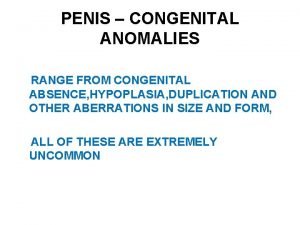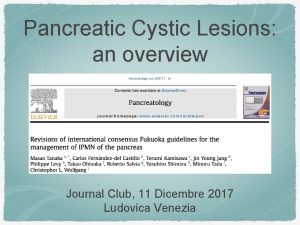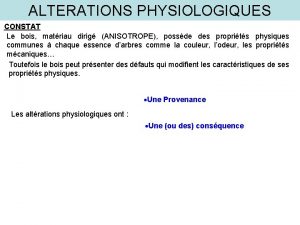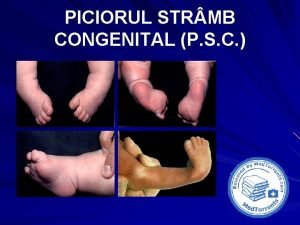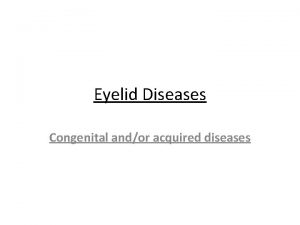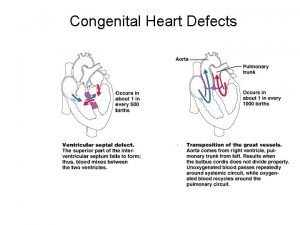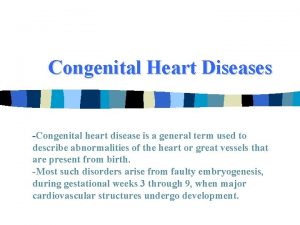Diseases of Penis PENIS Congenital anomalies Inflammations Tumors


















































- Slides: 50

Diseases of Penis

PENIS � Congenital anomalies � Inflammations � Tumors

Congenital lesions

Congenital anomalies � � � Complete absence Hypoplasia Hypertrophic / hyperplasic Epispadies ( Urethral opening on Ventral aspect of shaft of penis ) Hypospadies ( Urethral opening on Dorsal aspect of shaft of penis )

Congenital anomalies Phimosis - “inability to retract the foreskin on the glans penis”. Causes – i) congenital ii) Acquired - infections, scarring,

Congenital anomalies Paraphimosis : “Inability of retracted foreskin to return to normal position” �When phimotic prepuce is forcefully retracted over the glans, marked constriction and subsequent swelling may block the replacement of the prepuce , creating Paraphimosis. �It is painful and may cause urinary retention

Phimosis & Paraphimosis :

Inflammatory lesions

Inflammatory lesions �Acute ◦ Non-specific ◦ Specific �Chronic ◦ Non-specific ◦ Specific

Balanoposthitis � Non-specific infection of the glans and prepuce caused by a wide variety of organisms. � More common agents: Candida albicans, anaerobic bacteria, Gardnerella, and pyogenic bacteria. � Most cases occur as a consequence of poor local hygiene in uncircumcised males, with accumulation of desquamated epithelial cells, sweat, and debris, termed smegma, acting as local irritant. � Persistence of such infections leads to inflammatory scarring and, as mentioned earlier, is a common cause of phimosis.

INFLAMMATORY DISEASES: Acute inflammations �Trauma , Surgery , Infections like - Viral , Bacterial , parasitic , fungal ( e. g. - Syphilis , Gonorrhea, Trichomonas vaginalis , Candida etc ), ischemia �C/F: pain, fever, inguinal lymphadenopathy, and pelvic discomfort associated with discharge from the penis. �On examination –the penis is tender and reddish with seropurulent discharge. �On examination with Gram’s stain or Silver stain or Dark ground illumination the Causative organism is found

Chronic inflammations : �Non-specific – Herpes simples, HPV , others �Specific STD’s : Syphilis , Gonorrhea, LGV, Granuloma inguinale, Soft Sore, HIV, Trichomonas Vaginalis , Candida albicans etc

SYPHILIS ( T pallidum ) - Types - Congenital Acquired - Primary , Secondary , Tertiary stages � Penis lesions -(i) Chancre –(Hard Sore ) occur at penis, scrotum , consists of Single, firm, � non- tender, raised, red lesions , with exudates teeming with spirochetes. �(ii) Condyloma latum – broad based , elevated plaques , (iii) Gumma - Nodular lesions found in testis, , heart, liver, brain etc.

Syphilitic chancre �Photo with hard sore, on the glans penis. �Painless ulcer, erythematous lesion, �Yellow exudate.

Syphilitic chancre �Microphotograph showing =small blood vessel, with peri vascular chronic inflammatory cells, mainly lymphocytes, plasma cells, histiocytes, �Loss of elastic tissue is characteristic.

Syphillis �Condyloma lata of penis

GONORRHEA ( N gonorrheae ) Involve anterior urethra , �cause muco-purulent discharge + dysuria �Asst with fever, pelvic pain, �Urethral discharge on Gram stain shows�Gram negative cocci in the Neutrophils, & �In the exudate

LGV ( Chlamydia trachomatis – 1, 2, 3 types ) causes small transient painless ulcer � Vescicles, papule, � Inguinal Bubo

Chancroid �( Soft Sore ) – �(H ducreyi ) – Single , multiple ulcers painful, with ragged and �Undermined edges

Granuloma Inguinale �( Klebsiella granulomatis –Donovan Bodies ) : �Ulcers of irregular margins with necrotic floor, erythema , indurations, �with Inguinal Bubo

Genital Herpes (HSV- type 1. , 2 ) � produces irritable vescicles, � soon rupture to Produce small, tender, ulcers on the ext genitalia

Condyloma accuminatum ( HPV- type 6, 11 ) cause benign warts on the penis � Cause single or multiple exophytic popular or flat warts � Sometimes it may cause giant Condyloma ( Buschke-Lewenstain tumour )

Condyloma accuminatum �Penis showing greywhite papillary mass , arising from coronal sulcus, with red glands

Condyloma acuminatum �Sections shows predominantly papillary lesion, �having thin fibro vascular core and covered by mature stratified squamous epithelium. �Foci of necrosis are seen

Condyloma accuminatum �High power details of the lesion showing broad fronds of mature stratified squamous epithelium, �and parakeratosis, �hyperkeratosis


Other Infections �Molluscum Contagiosum, �Candidiasis , �Trichomonas vaginalis, etc

Tumours

TUMOURS �A ) Benign �i. Condyloma accuminatum � ii. Bowen’s disease �iii. Erythroplasia of Queyrat iv. Others

BOWEN’S DISEASE �Common after 35 yrs of age. �Produce single, thick, opaque plaques, �With shallow ulcer , crusting is seen.

BOWEN’S DISEASE �Photo shows scrotum with multiple small, encrusted plaque lesions of 0. 5 – 1 cms in size, �With shallow ulcer crusting is seen. �

BOWEN’S DISEASE �Micro-shows stratified squamous epithelium, with loss of polarity, �Atypical Sq. cells, in all the layers, �Hyperchromasia �increased mitosis, scanty cytoplasm,



ERYTHROPLASIA OF QUEYRAT �Same as Bowen’s disease �with severe dysplasia changes �at muco-cutaneous regions of the genitals in both sexes. �May progress to carcinoma

MALIGNAT TUMOURS I ) Sq. cell carcinoma - 93 – 95 % Ii ) Verrucus carcinoma - 0 – 2 % Iii ) Basal cell ca 0– 1% Iv ) Malignant melanoma - 0 - 1 % V ) Others - Rare

Epidemiology Increasing age, � Role of smegma , � Poor genital hygiene , � Circumcision Benefit Virus inf : HPV – 16, 18, 31 types , STD’s , Smoking –Polycyclic hydrocarbons ? �

Squamous cell carcinoma �Partial amputated specimen of penis. �There is exophytic growth arising from coronal areas/glands �Greywhite mass, areas of ulceration, hemorrhage �Everted edges

squamous cell carcinoma Cut-sections of the same specimen showing the tumour in the upper areas with corpora , Note the invasive foci Ares of necrosis, hemorrhage

squamous cell carcinoma �Gross of partial amputated penis, �Exophytic growth , with ulceration.

squamous cell carcinoma �Low power view of growth showing tumour composed of sq. cells tumour with �Invasion into deeper tissue

squamous cell carcinoma �High power details showing tumour tissue of Sq. cell type invading the deeper tissue. �Note the anaplasia, mitosis, �Stroma shows chr. inflammatory cells.

squamous cell carcinoma �Micro showing �well diff squamous cells, with formation of epithelial /keratin pearl, �surrounded by immature sq. cells, �Note chr. inflamm cells around the focus

Verrucus carcinoma �Variant of Sq. cell ca, with better prognosis, and slow growing nature. �Specimen shows huge exophytic growth, �everted edges, focal necrosis, hemorrhage

Verrucus carcinoma �Basically Sq. cell ca �Note the broad fronds of invading process. �Mainly consists of mature sq. cells, with areas of kertinization, �There is chr. inflamm cells around the margins

Verrucus carcinoma �Note the broad fronds on the invading tumour cells, �with keratinization.

Basiloid carcinoma �Varient of cancer charactirized by presence of mainly basal cells, �showing invasion, large hyperchromatic nuceli, �scanty cytoplasm.

spindle cell (sarcomatoid) Carcinoma �Varient of sq. cell ca of penis �characterized by mainly spindle cells, with interlacing arrangement �and mimicking sarcoma

Transitional cell carcinoma of penile urethra �Section shows �tumour composed of mainly transitional epithelial cells, �with central core of fibro-vascular areas, covered by abnormal transitional epithelium �Invasion , necrosis seen

Malignant melanoma �Excised specimen of dark pigmented mass of 1 – 2 cms in size, �mainly arising from scrotum, �or skin of penis.
 Mcgovern nipple
Mcgovern nipple Spina bifida
Spina bifida Most common congenital anomalies
Most common congenital anomalies Cercumscribe
Cercumscribe Kode icd 10 palatoschisis
Kode icd 10 palatoschisis Omphaloceole
Omphaloceole Acromely
Acromely Exocrine tumors of pancreas
Exocrine tumors of pancreas Cervical stenosis cervix
Cervical stenosis cervix Enneking staging
Enneking staging Bone tumors
Bone tumors Classification of tumors
Classification of tumors Peter hino md
Peter hino md Odontogenic tumors
Odontogenic tumors Spinal cord
Spinal cord Radiothrapy
Radiothrapy Classification of tumors
Classification of tumors Response evaluation criteria in solid tumors (recist)
Response evaluation criteria in solid tumors (recist) Classify odontogenic tumors
Classify odontogenic tumors Mobile phone brain tumour
Mobile phone brain tumour Benign and malignant tumors
Benign and malignant tumors Classification de robbins
Classification de robbins Odontogenic tumors classification
Odontogenic tumors classification Codman üçgeni
Codman üçgeni Ata thyroid
Ata thyroid Cfsv2 monthly prec anomalies
Cfsv2 monthly prec anomalies Attention anomalies
Attention anomalies Japan population pyramid
Japan population pyramid Défauts et anomalies du bois
Défauts et anomalies du bois Database anomalies
Database anomalies Polychromasia
Polychromasia Ralentissement variable atypique
Ralentissement variable atypique Anomalies du rcf pendant le travail
Anomalies du rcf pendant le travail Trading costs of asset pricing anomalies
Trading costs of asset pricing anomalies Anomalies of vitellointestinal duct
Anomalies of vitellointestinal duct Oddball: spotting anomalies in weighted graphs
Oddball: spotting anomalies in weighted graphs Data redundancy and update anomalies
Data redundancy and update anomalies Modification anomalies
Modification anomalies Accommodation anomalies
Accommodation anomalies Moral anomalies by raffaele garofalo
Moral anomalies by raffaele garofalo Congenital rubella syndrome triad
Congenital rubella syndrome triad Congenital hypothyroid
Congenital hypothyroid Congenital amusia
Congenital amusia Congenital diaphragmatic hernia
Congenital diaphragmatic hernia Congenital toxoplasmosis
Congenital toxoplasmosis Defect
Defect Non classical adrenal hyperplasia
Non classical adrenal hyperplasia Congenital glaucoma
Congenital glaucoma Picior stramb congenital talus valgus
Picior stramb congenital talus valgus Congenital rubella syndrome
Congenital rubella syndrome Klisic sign
Klisic sign



